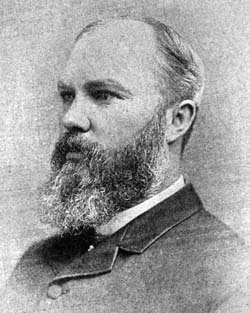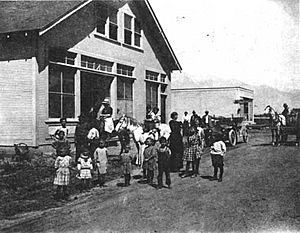Manzanar, California facts for kids
Quick facts for kids
Manzanar
|
|
|---|---|
| Country | United States |
| State | California |
| County | Inyo County |
| Elevation | 3,727 ft (1,136 m) |
Manzanar means "apple orchard" in Spanish. It was once a small town in Inyo County, California. This town was started by a water engineer and land developer named George Chaffey. Manzanar is most famous for being a place where Japanese Americans were held during World War II.
The town was located about 9 miles (14 km) north of Lone Pine. It sat along an old narrow-gauge railway line of the Southern Pacific Railroad. The elevation there is about 3,727 feet (1,136 meters) above sea level.
Manzanar had a post office from 1911 to 1914. It was a busy spot for shipping apples from nearby orchards. This was before water was sent from the Owens Valley to Los Angeles through the Los Angeles Aqueduct.
During World War II, the area became the site of the Manzanar War Relocation Center. This is where many people of Japanese background were forced to live.
Contents
Who Lived in Manzanar First?
Manzanar was first home to Native Americans almost 10,000 years ago. About 1,500 years ago, the Owens Valley Paiute people settled in this area. They lived across the Owens Valley, from Long Valley in the north to Owens Lake in the south. Their land stretched from the Sierra Nevada mountains in the west to the Inyo Mountains in the east.
The Owens Valley Paiute Way of Life
The Owens Valley Paiute hunted animals and fished in the rivers. They also gathered pine nuts and grew crops using irrigation in the Manzanar area. They traded pottery for salt from the Saline Valley. They also traded other goods across the Sierra Nevada during summer and fall.
How Settlers Changed the Valley
The Owens Valley did not get much attention from European Americans until the early 1860s. It was mostly a path through the area. But when gold and silver were found in the Sierra Nevada, many miners and farmers arrived. Their hungry cattle destroyed the Paiute people's crops. This led to conflicts.
About one-third of the Native Americans in the Owens Valley were moved to Fort Tejon. An Owens Valley Paiute elder, Irene Button, said they were forced to walk around the eastern shore of Owens Lake. This lake covers about 108 square miles (280 sq km). After 1863, many Paiute people returned to their villages. These villages were along creeks flowing from the Sierra Nevada mountains. In the Manzanar area, villages were along Bairs, Georges, Shepherds, and Symmes creeks.
Ranchers and Apple Orchards
When European American settlers first came to the Owens Valley in the mid-1800s, they found large Paiute villages near Manzanar. John Shepherd was one of the first new settlers. In 1864, he claimed 160 acres (65 ha) of land about 3 miles (5 km) north of Georges Creek. With help from Owens Valley Paiute workers, he made his ranch much bigger, to 2,000 acres (809 ha).
Growing Apples in Manzanar
By 1922, farmers in the area grew many apples, especially Winesaps. They had 400 to 500 acres (162 to 202 ha) of apple trees. Even with limited water, the area was known for its fruit. In 1925, Manzanar was called "one of the best apple and peach districts in California."
The Town of Manzanar
In 1905, George Chaffey, a developer from Southern California, bought Shepherd's ranch. He divided it into smaller plots, along with other nearby ranches. He officially started the town of Manzanar in 1910. It was located on the main line of the Southern Pacific railroad. By August 1911, the town had nearly 200 people.
Building the Town
A company called Manzanar Water Company was started in 1910. It had $250,000 to invest. The company built an irrigation system for over a thousand acres. They planted about twenty thousand fruit trees.
In January 1911, a telephone line was approved. It connected Manzanar to other towns like Independence and Lone River. Ira L. Hatfield was the town's first postmaster in May 1911. The first post office was in a town 1.5 miles away called Thebes.
In summer 1911, a new building was put up for the community. The first floor had a hall for public meetings, church, Sunday school, and dancing. It also had rooms for offices and small businesses. The upper floor was planned for club meetings.
By 1920, Manzanar had more than twenty-five homes, a two-room school, a town hall, and a general store. Almost 5,000 acres (2,023 ha) of apple, pear, and peach trees were growing. Farmers also grew grapes, prunes, potatoes, corn, and alfalfa. There were large vegetable and flower gardens too.
Martha Mills, who lived in Manzanar from 1916 to 1920, said, "Manzanar was a very happy place and a pleasant place to live during those years." She remembered its orchards, fields, and tree-lined lanes.
Los Angeles Needs Water

In 1913, the City of Los Angeles finished building its 233-mile (375 km) Los Angeles Aqueduct. But Los Angeles was growing fast and needed even more water. So, in 1920, city officials started buying water rights in the Owens Valley. Over the next decade, Los Angeles bought land from many farmers in the Owens Valley. By 1933, the city owned 85 percent of all town property and 95 percent of all farm land in the valley, including Manzanar.
The End of Manzanar as a Town
Some residents sold their land and moved away. But many wanted to stay. In dry years, Los Angeles pumped water from underground and took all the surface water. This left Owens Valley ranchers without water for their crops. Without water, these farmers had to leave their ranches and communities. This included the town of Manzanar, which was empty by 1929.
Lucille DeBoer, who lived on a ranch in Manzanar, remembered a time when there was so much water that it came up to a horse's knees when it pulled a buggy. She said, "In the early 1900s the City of Los Angeles started to purchase ranches in the Owens Valley for the sole purpose of supplying water to the people in Los Angeles." She explained that as the city bought land and drained water, "the trees began to die; and the land finally turned to vacant dirt. This ended the Land of the Big Red Apples."
By August 1924, Los Angeles had bought the Manzanar area for $780,000. The city bought 4,958 acres (2,006 ha) of land in 68 parts for $788,120. This land was located between the north end of the Alabama Hills and the town of Independence, California. It was fed by several creeks. The city's engineer, William Mulholland, said the land would be very useful as an underground water storage area.
By 1925, fewer people lived in Manzanar. The town's two-teacher school was expected to have only seven students. The Manzanar and Independence school districts were combined. But this combined district was closed in 1934.
The ranches remained, and Los Angeles offered to lease the land and buildings. Many farmers who had sold their land then leased their farms back. Some even got water from a new well. Victor M. Christopher was hired by the city to manage the land and leases.
Manzanar stayed empty until the United States Army leased 6,200 acres (2,509 ha) from Los Angeles. This land was used for the Manzanar War Relocation Center.
Images for kids
-
The Alabama Hills, 2009





